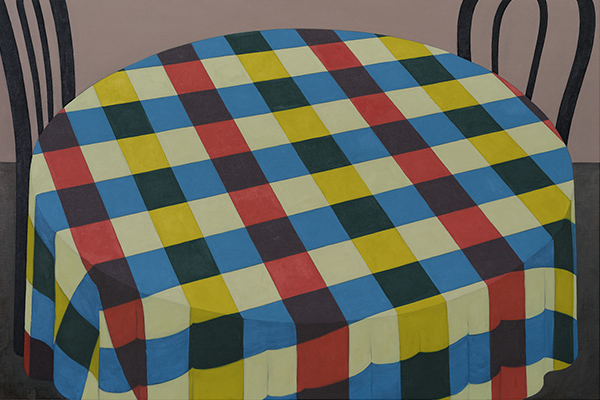2022
Kathleen Ryan, Daisy Chain, published by Karma, New York, 2022
To find the freshest fruit, we typically attend to color, texture, and density. We look for lemons with smooth, bright, evenly hued skin and firm, hefty bodies. We look for grapes that are firm, plump, and securely attached to the stem. Cherries should be a deep, saturated, glossy red; their stems, green. A fresh pumpkin, orange and hard-shelled, should sound hollow when we knock on it. Fresh fruits often epitomize their chromatic namesakes. Their outside touch hints at their interior structure and texture. Yet there’s an affective dimension to ripeness and freshness, too. As artist Kathleen Ryan has described, ripeness is also about pressure—simultaneously concrete, elastic, and erotic.
In her Bacchante (Tall White) (2016), Ryan evoked pressure with balloons and polished concrete—juicy, bowling ball-sized orbs bunched together with stems composed of metal chain. By making utilitarian materials “sexy and lush,” Ryan juxtaposed buoyancy and weight, ripeness and inertness, organicism and industrialism. In her summer 2021 exhibition at Karma Gallery in New York, Ryan extends this exploration through new floral forms: cherries, lemons, pumpkins, and daisies that express their “lushness” not through erotic pressure, but through decay—and that, for those attuned to more pervasive forces of social and climatic disintegration, might reveal how ripeness and freshness are products of industrial apparatae and vast extractive infrastructures.
Upon entering the gallery, we first encounter Daisy Chain (2021), a garland bearing all the chromatic indicators of peak freshness: snowy white petals, sunny yellow disc florets, and verdant stems. Yet this chain, like Ryan’s grapes, is composed of industrial materials: petals made of vinyl, sepals fashioned from green funnels, leaves contrived from green garden spades, yellow drain head florets, and interspliced stems of green irrigation hose—all components of industrialized agriculture’s manufacturing of freshness. An earlier piece, Bad Grapes (2020), used copper pipes as stems and branches.
“Far from a natural state,” freshness, geographer Susanne Freidberg argues, depends on “a host of carefully coordinated technologies, from antifungal sprays to bottle caps to climate-controlled semi trucks.”1 We could add to this list patented, genetically engineered seeds, refrigerated warehouses, irradiation, shrink wrap, and food safety laws—along with irrigation hoses and sprinkler heads.2 Ryan’s colossal floral assemblage, sure to win any 4-H prize for “biggest daisy,” hangs from three metal ceiling hooks, reminding us that agribusiness’s genetic modification and selective breeding also prioritize size: bigger farms, bigger plants and animals, bigger yields, bigger profits. These expansive tendencies cultivate chickens too big to stand on their own two legs, apples that sacrifice taste for girth, and exploitative labor practices. Poorly paid, precarious migrant laborers must move quickly to push fresh produce to market—markets those same laborers typically can’t afford. As Freidberg acknowledges, “the qualities that make freshness seem natural have also traditionally made it a marker of wealth and social status.”3
Ryan’s plastic garland, propagated polymerically for perpetual verdure, might direct our attention toward the artificial apparatae and infrastructures scaffolding our organic aspirations toward freshness and abundance. Immediately behind the garland sits a massive steel basket, originally manufactured to transport large tanks of liquid, like pesticides—another emblem of industrialized farming—but which here holds jumbo cherries the size of basketballs. Ryan’s Bad Cherries (2021) are firm and glossy, as ripe cherries ostensibly should be, but here that shine isn’t an index of freshness. These fruits, carved from polystyrene, are “bedazzled” with gems and minerals: red aventurine, jasper, rhodolite, and carnelian create a gradation of reds; while amazonite, aventurine, fluorite, turquoise, malachite, angelite, labradorite, freshwater pearl, quartz, and rainbow moonstone evoke an iridescent blue-green-white mold; and dark agate and garnet signal rot. The fruits’ stems are composed of fishing rods weighted with lead sinkers, creating another kind of material tension: unlike the ripe, erotic pressure building up inside the grape skin, the tension here is that of gravity pulling these languishing bodies toward the ground.
Walking into the back gallery, we then encounter a rotting pumpkin, Jackie (2021)—a sad post-Halloween jack-o-lantern almost the size of Cinderella’s pumpkin coach (some of Ryan’s earlier works also referenced technologies of mobility; Bad Melon, 2020, was constructed inside chunks of an Airstream trailer). Visible steel nails affix orange acrylic beads to the pumpkin’s warty exterior. Its carved-out top is cast off to the side. Peering into the gourd through its roughly carved facial features, or from its crown, we find a veritable Hall of Gems: radiant rocks and geodes that symbolize stale flesh, mold, and decay—from the pinks and whites of rose quartz, red aventurine, quartz, and calcite; to the golds and oranges of citrine, brecciated jasper, and carnelian; the greens of ching hai jade, moss agate, and malachite; the blues of azurite-malachite, lapis lazuli, and labradorite; the purple of amethyst; the blacks of smoky quartz and onyx; and the polychromatism of agate.
A few doors down 2nd Street, in Karma’s other gallery, we add some additional fruits to our basket: four loose cherries and three lemons. Lemons are complex symbols: their juices are used to preserve and purify, yet to call something a “lemon” means that it’s defective, disappointing. These lemons—with their flesh made from grey-yellow prehnite and yellow-green peridot, and abundant mold fashioned with Swarovski crystal and pearl—turn the defective bits into treasure.
As with many of the other fruits in Ryan’s cornucopia, the more spoiled the spot, the more precious its component materials. Her work comments on the extensive physical resources and financing required to impede natural forces of decay, to counter entropy. Yet food waste— epitomized here by the tradition of carving a pumpkin only to discard it after it serves its seasonal ornamental role—remains a massive problem, and industrialized agriculture commands much of the world’s water supply and generates widespread pollution.4 The portrayal of rot also reminds us of the increasing vulnerability of our food supply to global pathogens—particularly in an age of monocultural cultivation and climate change.5
Yet Ryan’s gems and geodes also refract our gaze, compelling us to consider the potential value of decay itself. Consider spalted wood, which features colored marbling that reveals the traces of fungus-induced decay, and is prized by woodworkers. Think, too, about fermentation, which involves the controlled breakdown of a substance by microorganisms, and can generate food with greater health benefits and enhanced food safety.6 As American Studies scholar Justin Abraham Linds explains, fermentation was central to the creation of value in the Caribbean plantation system: fermentation transformed raw sugarcane into a commodity, and it allowed colonists to collect and preserve natural history specimens. “Fermentation and rot had to be mastered by colonists desiring to produce ideal commodities, ideal nature, and ideal human bodies,” Linds writes.7 In the production of kimchi, alcohol, and sugarcane—as with the creation of Ryan’s artifacts—degradation is not a product of neglect; to the contrary, fermentation and rot are meticulously plotted and executed with great knowledge and care.
Planned decay is also deployed in archivy, where cultural heritage practitioners face limits on what they can preserve, and thus must orchestrate the “graceful degradation” of particular materials.8 Art conservators face similar challenges with works that are meant to be ephemeral: performance pieces, sculptures made of ice, audio tapes that eat themselves. Geographer Caitlin DeSilvey, echoing Freidberg, notes that “massive amounts of energy are invested to keep heritage systems”—like historic sites, landscapes, and monuments—“in a steady state so that the matter contained within them will continue to function as a cultural mnemonic device.” Instead, she advocates that historic preservationists embrace the ethos of “curated decay”—letting things go, letting things change, letting things collapse, accepting that “processes of aging and decay can be additive as well as destructive,” acknowledging that “what may appear as erasure on one register may be generative of new information on another.”9
Ryan’s sculptures are composed of materials—plastics and rocks—that will surely outlast any exhibition or gallery. But in using these non-perishable substances to capture the fragility of life, she prompts us to consider the resources deployed in its preservation, and to wonder if we might find beauty and humility in its cultivated decomposition.
1 Susanne Freidberg, Fresh: A Perishable History (Harvard University Press, 2009): 2.
2 See also Benjamin R. Cohen, Pure Adulteration: Cheating on Nature in the Age of Manufactured Food (University of Chicago Press, 2019).
3 Freidberg: 7.
4 Courtney Lindwall, “Industrial Agricultural Pollution 101,” NRDC (July 31, 2019): https://www.nrdc.org/stories/ industrial-agricultural-pollution-101.
5 Myles Karp, “Rotting-Fruit Art Points Up Plants in Peril,” National Geographic (December 27, 2019): https://www. nationalgeographic.com/science/article/rotting-fruit-art-points-up-plants-in-peril.
6 Anna K.rlund, et al., “Harnessing Microbes for Sustainable Development: Food Fermentation as a Tool for Improving the Nutitional Quality of Alternative Protein Sources,” Nutrients 12:4 (2020): https://www.ncbi.nlm.nih. gov/pmc/articles/PMC7230334/; Chrysa Voidarou et al., “Fermentive Foods: Microbiology, Biochemistry, Potential Human Health Benefits and Public Health Issues,” Foods 10:1 (2021): https://www.ncbi.nlm.nih.gov/pmc/articles/PMC7823516/.
7 Justin Abraham Linds, “Fermentation, Rot, and Power in the Early Modern Atlantic,” Edge Effects (August 11, 2020): https://edgeeffects.net/fermentation-rot-and-power/.
8 Bethany Nowviskie, “Graceful Degradation” (July 10, 2009): https://nowviskie.org/2009/graceful-degradation/.
9 Caitlin DeSilvey, Curated Decay: Heritage Beyond Saving (University of Minnesota Press, 2017): 11, 13, 20



